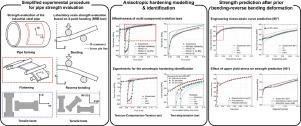International Journal of Mechanical Sciences ( IF 7.3 ) Pub Date : 2021-05-18 , DOI: 10.1016/j.ijmecsci.2021.106512 Hongjin Choi , Seonghwan Choi , Soo-Chang Kang , Chanyang Kim , Myoung-Gyu Lee

|
In this study, the strengths of a steel pipe in different material orientations are predicted using a distortional anisotropic hardening model, namely, the HAH model, implemented in a finite element simulation. The investigated hardening can capture the transient flow behavior under bending and reverse bending strain paths. In addition, the model reproduces the material behavior under orthogonally applied tension from the prior deformation path. To improve the predictive accuracy of the existing distortional hardening model, we additionally implement the multi-component evolution rule of the Bauschinger effect and transient hardening behavior. Two-step tension tests are used to identify the constitutive parameters related to the loading path changes in the bending and reverse bending (BRB) test, which mimics the common pipe manufacturing process in a practical manner. The predicted strengths along the circumferential and transverse directions to the major bending direction agree well with the experimentally measured strengths when the distortional hardening model is employed. By contrast, the classical isotropic hardening and kinematic hardening model over- and under-estimate the yield strength of the specimens after prior BRB loading. The improved accuracy of the strength prediction with the investigated HAH is attributed to the anisotropic identification of the flow behavior under both load reversal and cross-loading conditions, whereas the isotropic-kinematic hardening only considers the back stress evolution at load reversal. In addition to the strengths, the stagnated flow behavior after BRB loading can be well predicted with the HAH model with a properly calibrated yield point elongation using an inverse identification method.
中文翻译:

预弯反弯变形后钢板各向异性强度预测:应变硬化模型的应用
在本研究中,使用在有限元模拟中实施的畸变各向异性硬化模型(即 HAH 模型)来预测钢管在不同材料方向上的强度。研究的硬化可以捕获弯曲和反向弯曲应变路径下的瞬态流动行为。此外,该模型再现了先前变形路径中正交施加的张力下的材料行为。为了提高现有畸变硬化模型的预测精度,我们额外实施了包辛格效应和瞬态硬化行为的多分量演化规则。两步拉伸试验用于确定与弯曲和反向弯曲 (BRB) 试验中加载路径变化相关的本构参数,它以实用的方式模仿了常见的管道制造过程。当采用变形硬化模型时,沿圆周方向和横向到主要弯曲方向的预测强度与实验测量的强度一致。相比之下,经典的各向同性硬化和运动硬化模型高估和低估了先前 BRB 加载后试样的屈服强度。所研究的 HAH 强度预测精度的提高归因于对载荷反转和交叉载荷条件下流动行为的各向异性识别,而各向同性运动硬化仅考虑载荷反转时的背应力演变。除了实力,


























 京公网安备 11010802027423号
京公网安备 11010802027423号